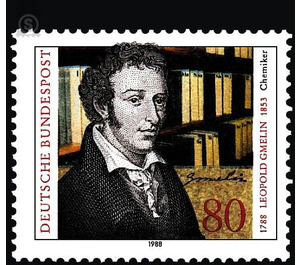200th birthday of Leopold Gmein - Germany / Federal Republic of Germany 1988 - 80 Pfennig
Theme: Calender
| Country | Germany / Federal Republic of Germany |
| Issue Date | 1988 |
| Face Value | 80.00 |
| Color | multi-colored black |
| Perforation | K 14:13 3/4 |
| Printing Type | combined intaglio and offset printing |
| Stamp Type | Postage stamp |
| Item Type | Stamp |
| Chronological Issue Number | 1250 |
| Chronological Chapter | GER-BRD |
| SID | 243720 |
| In 42 Wishlists | |
If one wants to outline the life of Leopold Gmelin, who was one of the most famous and important German representatives of his science in the first half of the 19th century, one must name four places: Göttingen, Tübingen, Heidelberg and Frankfurt am Main. Born into a Swabian family, Gmelin was born in northern Germany, where his father, a professor at the University of Göttingen, taught chemistry in particular. He grew up in Göttingen, where he heard the first paternal chemistry lecture, and from 1805 to 1809 he studied medicine there. Gmelin's second place of study was Tübingen, home and the spiritual center of his family, which has been providing numerous university teachers there for decades. The five semesters, which he spent in 1804/05 and 1809 - 1811 in Tübingen, were not only dedicated to medicine, but also served - in the pharmacy of a relative - the introduction to practical pharmacy. In 1813 Gmelin started his professional career as a Privatdozent for chemistry and mineralogy in Heidelberg. He rose rapidly in the hierarchy of the university; In 1814 he became an associate professor and in 1817 a full professor. In 1830/31 he served as prorector for his university, several times as dean. Appeals to Berlin and Göttingen he refused. In 1851 he resigned, highly honored both at home and abroad, for illness's sake. As an experimenter Gmelin was very successful. His work, of which the physiological-chemical experiments on digestion, carried out together with Tiedemann, extended to many fields of chemistry. The red blood lye salt, which he describes for the first time, is also called Gmelin's salt, and a long-used sample of bile pigments also gives his name. Even as a teacher he enjoyed prestige, and men like Wöhler, Kopp, Löwig, Fehling and Williamson were among his students. Gmelin earned recognition as a writer beyond his time. In his "Handbook of Theoretical Chemistry", published by a Frankfurt publisher from 1817 to 1819, he attempted to offer the reader all the chemical knowledge in a well-ordered, complete and objective manner, without any unnecessary accessory, but with references to errors and contradictions. "Since we have your manual, it is no longer art to be a learned chemist," said the Swede Berzelius about the work, which was reissued several times. The 8th edition, published today by the Frankfurt-based Gmelin Institute, which is part of the Max Planck Society, which describes inorganic and organometallic chemistry, is an indispensable component of international chemistry documentation. It currently has about 570 volumes and will soon be supplemented by an electronic database. (Text: Dr. Bernd Wöbke, Gmelin Institute, Frankfurt am Main)


